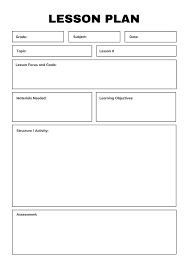Writing a lesson plan is an essential skill for educators, which helps them structure their lessons and ensure they meet the learning objectives for their students. Whether you’re a new teacher or an experienced educator looking to refresh your approach, having a printable lesson plan template can streamline the process. Here’s how to write one:
Title: Start by naming your lesson plan. The title should give a clear indication of the subject or topic.
Objective: Clearly state what the students should be able to do by the end of the lesson. Objectives should be specific, measurable, achievable, relevant, and time-bound (SMART).
Materials: List all materials and resources you and your students will need during the lesson.
Introduction: Plan an engaging start to your lesson that will get students’ attention and prepare them for learning.
Instruction: Detail the main content of your lesson, including lectures, discussions, readings, and demonstrations. Consider how you’ll present information and explain key concepts.
Activities: Prepare student-centered activities that reinforce your instructional content. This could include group work, hands-on tasks, problem-solving exercises, or creative projects.
Practice: Decide on opportunities for students to practice skills or apply knowledge, ensuring these exercises align with your lesson objectives.
Assessment: Outline how you will assess student understanding—this could be through questions, quizzes, observations, or other assessment tools.
Conclusion: Plan a summary or closing activity that will help consolidate learning and tie all elements of your lesson together.
Differentiation Strategies: Consider how you will tailor your lesson to meet a range of abilities and learning styles within your classroom.
Follow-up: Think of homework assignments or activities that can extend learning beyond the classroom.
Here is a simple printable template based on this structure:
Lesson Plan Template
– Title:
– Date:
– Subject/Grade Level:
– Duration:
—
– Objective(s):
–
–
—
– Materials/Resources:
–
—
– Introduction (Warm up/Engagement):
–
—
– Instruction (Content/Delivery):
–
—
– Activities (Student-Centered):
–
—
– Practice/Application:
–
—
– Assessment (Formative/Summative):
–
—
– Conclusion (Wrap up):
–
—
– Differentiation Strategies:
–
—
– Follow-up/Homework:
–
—
Remember to leave space between each section for detailed notes and adjust each part as necessary for specific lessons. Keep it flexible enough to accommodate the dynamic nature of classroom teaching. With this printable template in hand, teachers can approach each class organized and prepared to deliver effective and engaging lessons.





